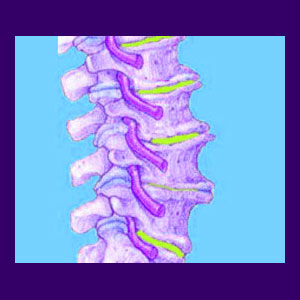
Nerve impingement is yet another technical name for a pinched nerve, also known as a compressed nerve or compressive neuropathy. Impingement describes crowding or constriction of a neurological structure, typically by a bulging disc or arthritic bone spur complex. However, impingement can also take place by an abnormal spinal curvature, a subluxated vertebra or even a soft tissue pathology, such as a powerful back muscle spasm. Just remember that impingement concerns, just like all neurological diagnoses, are often incorrect or only partially correct, leading the patient on an unnecessary quest for treatment.
This essay will focus on impingement of the spinal nerve roots within the central canal or as they exit through the neuroforamen. However, we will also examine a few non-spinal sources of nerve impingement which may also be involved in neck, back or sciatica pain expressions.
Nerve Impingement Defined
Nerves are conduits of electrical activity between the brain and the rest of the anatomy. Each nerve carries impulses to highly specific parts of the body, making it rather clear to definitively diagnose which nerve tissues are affected, depending on where the symptoms present themselves.
Nerve messages may be sensory, motor or autonomic in nature and travel in both directions. Sensory signals travel from the area of the body served to the brain and provide sensations of pain, temperature, texture and many other criteria. Motor impulses travel from the brain to the served area, instructing the muscles how and when to move. Autonomic nerve messages are not consciously controlled and dictate many of the automatic processes which go on beneath our level of consciousness throughout the anatomy, such as digestion, heart rhythm and chemical production, among many, many others.
Impingement is an actual blockage in a nerve pathway enacted by a structural concern. When the nerve can not relay messages, it simply stops functioning. Impingement can also occur in the spinal cord itself, which is the worst possible case scenario. Being that the spinal cord controls virtually all neurological processes, compression will usually enact horrific symptomatic expressions anywhere in the body lower than the narrowed canal location. This is called spinal stenosis.
Nerve Impingement Diagnostic Conclusion
The most common causes of nerve compression in the spine can include any of the following causative mechanisms:
Prolapsed discs can bulge acutely into the spinal nerves or spinal cord. Rarely are herniations the source of chronic pain due to neurological constriction. However, they may elicit ongoing neurological concerns, such as paresthesia and weakness in the areas of the body served by the impinged nerve.
Arthritic bone spurs can crowd nerve roots or block the central canal. Arthritic compression is difficult to treat nonsurgically and may require back surgery.
Anterolisthesis and retrolisthesis can trap nerves or the spinal cord in the misaligned central canal or in disjointed foramen when vertebral displacement is severe.
Scoliosis might impinge on nerves by constricting them in a decreased apex of a side to side curvature,
Abnormal lordosis and kyphosis rarely influence nerves, but in cases of extreme exaggerated versions of either, nerves may become compressed in a narrowed central or foraminal canal.
The most common diagnoses involving nerve impingement outside the spine include:
Piriformis syndrome is a condition in which the sciatic nerve is trapped and pressured by the piriformis muscle. This form of compression is known to source sciatica symptoms.
Thoracic outlet syndrome is defined as muscular compression of the nerves within the brachial plexus, usually caused by the scalene muscles.
It should be noted that actual nerve compression should only be painful for a short time and then follow with objective numbness and weakness. Chronic back pain blamed on a truly pinched nerve is a gross exception to the symptomatic rule. However, this does not apply if the compressed structure is the spinal cord.
Impinged Nerve Guidance
I see so many misdiagnosed back pain conditions blamed on nerve compression issues, usually by chiropractors and orthopedists. In most cases, there is some evidence that a nerve is experiencing some crowding or the foraminal space is narrowed, but there is no proof that compression exists.
Remember to compare the actual expected symptoms of a pinched nerve at your theorized level to the actual symptoms you have. In most cases, some will match, but you might have far more symptoms than can be adequately explained using the structural model of pain.
Your neurologist will be able to help you in this process and I strongly recommend using their services for any suspected diagnosis of nerve pain.





